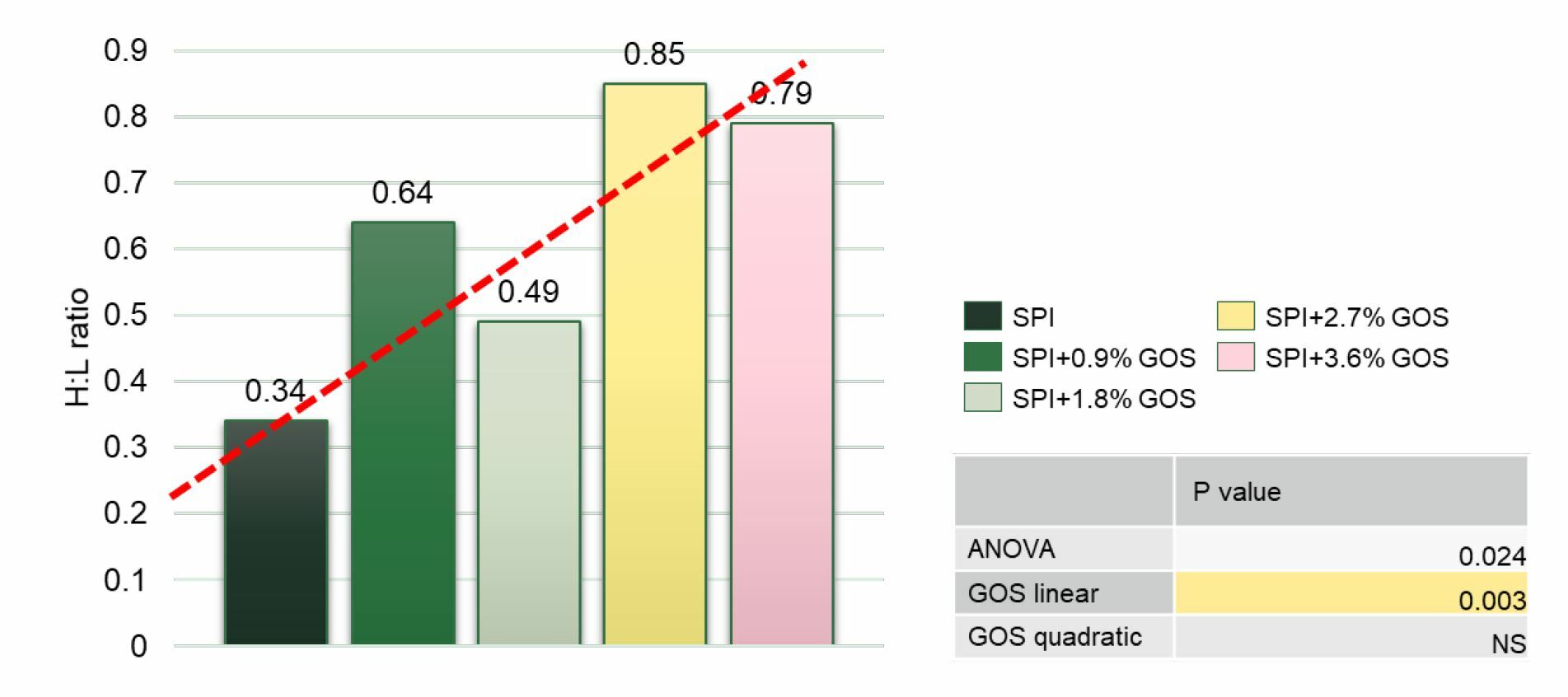



Groundbreaking findings: University of Arkansas discovers that stress in chickens can be related to dietary soy galacto-oligosaccharides
Which type of processed protein should be the product of choice in starter diets for chicks?In our previous article published in The Poultry Site (Blanch et al., 2022), we presented extraordinary new findings from the University of Arkansas on the negative effect of soy galacto-oligosaccharides stachyose and raffinose (GOS) on the productive performance of young chicks (Teague et al., 2021). For the first time, the maximum level of soy GOS that should be present in broiler starter diets was established, being between 1.2 and 2%. Higher levels of soy GOS in starter diets impair feed efficiency. It was concluded that, considering literature showing that a GOS level in the range of 1.75 to 3.5% can be expected in a broiler starter diet with 35% SBM, it is not unlikely that young chickens are fed a GOS level that exceeds the threshold of 1.2-2% in the final feed.
In the same study carried out at the University of Arkansas, the effects of increasing levels of GOS in the starter diet at the intestinal and systemic levels were also studied, as we describe below.
In the past, Perryman et al. (2013) had already described a relationship between the content of GOS in the diet and the incidence of pododermatitis in chickens. However, until now, dose-response trials with GOS in chickens have not been carried out to find out if there is a maximum level that generates wet litter or if, on the contrary, the response is linear and, therefore, there is not a cap. In our study at the University of Arkansas, with GOS levels between 0% and 3.6% in the starter diet (analyzed to <0.53-3.05%), a linear and significant effect of GOS level on moisture content in chicken droppings was observed (Figure 1). The higher the level of GOS in the starter feed, the higher the moisture content in excreta.

Figure 1. Effect of the level of soy GOS in starter diets on moisture content in excreta at 14 days of life.
As we indicated in a previous article on this website (Blanch, 2020), undigested stachyose and raffinose, exert an osmotic effect in the duodenum and jejunum portion of the intestinal tract until they are fermented in the cecal tonsils. However, as we have seen, only a small part of these GOS is fermented. Therefore, higher osmotic pressure from consumption of noxious quantities of soy GOS generates abnormally aqueous digesta that increases the feed passage rate in broilers. This type of liquid droppings is therefore feed-induced and does not have to be initially related to any bacterial infection. Thus, to some extent, high levels of GOS in the diet can compromise chick health and welfare. Therefore, we recommend that the content of GOS in starter feeds be reduced below the threshold mentioned above, by using clean soy protein sources.
The most novel finding in this study was that the soybean GOS in the starter feed not only have effects at the intestinal level but also have effects at the systemic level. Thus, as shown in Figure 2, a linear effect of GOS content in the starter diet on the ratio of heterophils to lymphocytes (H:L) in blood was observed. As the GOS content in the starter diet increases, the H:L ratio in the blood also increases.

Figure 2. Effect of the level of soy GOS in starter diets on heterophils to lymphocytes ratio (H:L) in blood of chicks at 14 days of life.
It is well acknowledged that stress induces significant alterations in the H:L ratio in birds, which can be attributed, at least to some extent, to an increase of the glucocorticoid hormone, corticosterone. In any case, the H:L ratio in blood is a good marker of stress in broilers. As indicated by Scanes (2016), there have been extensive series of studies reporting that the H:L ratio and corticosterone in blood of chickens are elevated by multiple stressors such as the following: E. coli and Salmonella challenge, fasting, feed restriction, heat stress, lighting sources, shackling or transportation stress. The novelty of our study in collaboration with the University of Arkansas is that, for the first time, it is shown that indigestible GOS in soy can also be one of the stressors that lead to high H:L ratios in young chickens.
Stress may exert several effects in chickens such as decreased growth, lessens in protein synthesis and increases in degradation in skeletal muscle, depressed immune system or reduced gastrointestinal functioning (Scanes, 2016). Any type of stress during the starter period will therefore have consequences on the growth and health of the birds for the rest of their lives. This could explain why we observe a positive carry-over effect on broiler performance during the grower and finishing phases when birds have been previously fed a starter diet in which part of its soybean meal has been replaced with a low GOS protein, such as enzymatically treated soy protein (Bjedov S et al., 2015; Lumpkins et al., 2017; Rasmussen et al, 2019, 2020, 2021; Steed et al., 2020).
As we have previously published on this website (Blanch, 2021), among the various industrial processes to reduce the content of antinutritional factors in soybean meal, the enzymatic treatment is the one that results in the lowest GOS content. Therefore, this type of processed protein should be a product of choice in starter diets for chicks and thus ensure the correct performance of the birds until the end of the production cycle.
Literature references
Bjedov S et al. (2015). Effect of replacing soybean meal with different protein sources during strater period on performance and footpad dermatitis in broilers. 20th European Symposium on Poultry Nutrition Full Papers. P200 (ID 197): 507-509.
Blanch A (2020) Soy oligosaccharides and beta-conglycinin, behind gut inflammations, wet droppings and footpad dermatitis in chickens. https://www.thepoultrysite.com...
Blanch A (2021). If you reduce the content of soybean meal in your starter feed, be careful what you replace it with! https://www.thepoultrysite.com...
Blanch A et al. (2022). Newsflash: University of Arkansas confirms to what extent soy stachyose and raffinose in broiler starter diets impair bird performance. https://www.hamletprotein.com/...
Lumpkins B et al. (2017). Evaluation of HP Avistart in broiler starter diets with and without an antibiotic feeding program. 21st European Symposium on Poultry Nutrition (abstract available on request).
Perryman KR et al (2013) Growth performance and meat yields of broiler chickens fed diets containing low and ultra-low oligosaccharide soybean meals during a 6-week production period. Poult. Sci., 92: 1292–1304. https://doi.org/10.3382/ps.201...
Rasmussen SH et al. (2019). Effect of an enzyme-treated soy protein on the performance of broiler chickens infected or uninfected with Clostridium perfringens. Poultry Science Association 108th Annual Meeting Abstracts. Abstract #360, page 145.
Rasmussen SH et al. (2020). Effect of the inclusion of enzyme-treated soy protein in starter diets of two different amino acid density feeding programs on performance of broiler chickens. Poultry Science Association 109th Annual Meeting Abstracts. Abstract #204, page 101.
Rasmussen SH et al. (2021). Growth performance of broiler chickens fed enzyme-treated soy protein day 0-14 compared to exogenous protease fed day 0-56. 2021 Virtual International Poultry Scientific Forum Abstracts, P52. https://poultryscience.org/fil...
Scanes CG (2016). Biology of stress in poultry with emphasis on glucocorticoids and the heterophil to lymphocyte ratio. Poult. Sci. 95:2208–2215. http://dx.doi.org/10.3382/ps/p...
Steed J et al. (2020). A comparative analysis of an enzymatically processed soybean meal protein and non-SBM protein sources on broiler live performance and economic benefit under NAE conditions. 2020 International Poultry Scientific Forum Abstracts. AbstractT176, page 54.
Teague KD et al (2021). Dietary soy oligosaccharides affect the gastrointestinal health and feed efficiency of growing chicks. In: Proceedings of the Symposium on Gut Health in Production of Food Animals, St. Louis, Missouri, Oct 1 – Nov 3, 2021: 4











